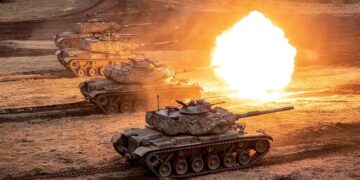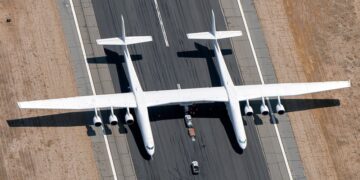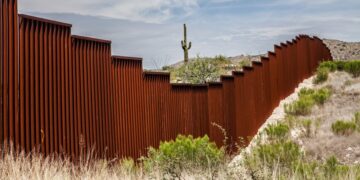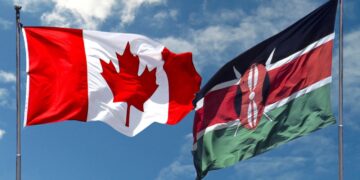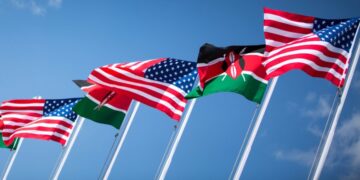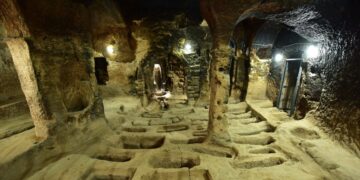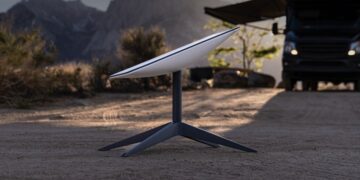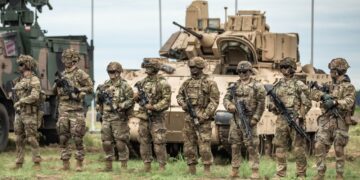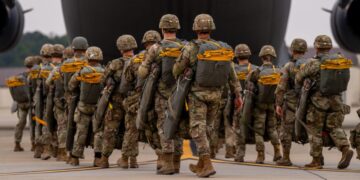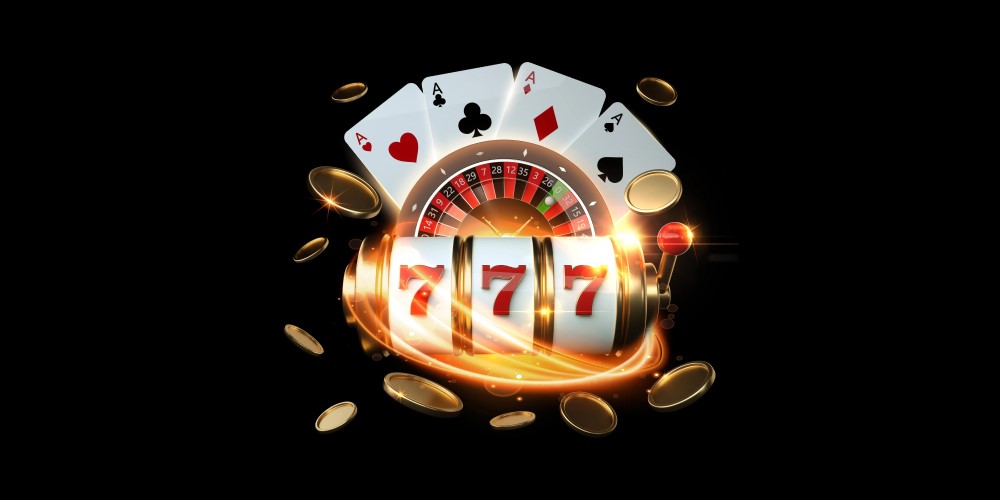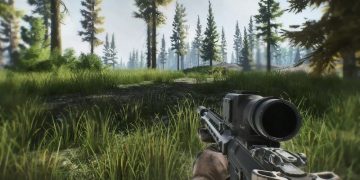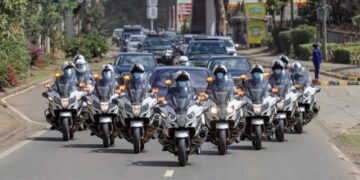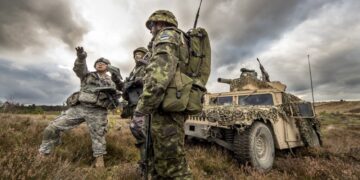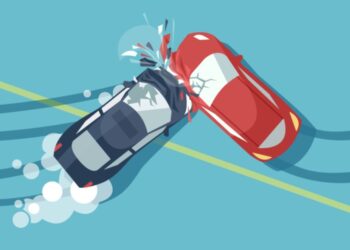A nuclear weapon (also known as an atom bomb, atomic bomb, nuclear bomb or nuclear warhead, and colloquially as an A-bomb or nuke) is an explosive device that derives its destructive force from nuclear reactions, either fission (fission bomb) or a combination of fission and fusion reactions (thermonuclear bomb), producing a nuclear explosion. Both bomb types release large quantities of energy from relatively small amounts of matter.
The first test of a fission (“atomic”) bomb released an amount of energy approximately equal to 20,000 tons of TNT (84 TJ). The first thermonuclear (“hydrogen”) bomb test released energy approximately equal to 10 million tons of TNT (42 PJ). Nuclear bombs have had yields between 10 tons TNT (the W54) and 50 megatons for the Tsar Bomba. A thermonuclear weapon weighing as little as 600 pounds (270 kg) can release energy equal to more than 1.2 megatons of TNT (5.0 PJ).
A nuclear device no larger than a conventional bomb can devastate an entire city by blast, fire, and radiation. Since they are weapons of mass destruction, the proliferation of nuclear weapons is a focus of international relations policy. Nuclear weapons have been deployed twice in war, by the United States against the Japanese cities of Hiroshima and Nagasaki in 1945 during World War II.
Tactical nuclear weapons
A tactical nuclear weapon (TNW) or non-strategic nuclear weapon (NSNW) is a nuclear weapon which is designed to be used on a battlefield in military situations, mostly with friendly forces in proximity and perhaps even on contested friendly territory. No tactical nuclear weapon has ever been used in a combat situation. Tactical nuclear weapons include gravity bombs, short-range missiles, artillery shells, land mines, depth charges, and torpedoes which are equipped with nuclear warheads.
Also in this category are nuclear armed ground-based or shipborne surface-to-air missiles (SAMs) and air-to-air missiles. Small, two-man portable or truck-portable tactical weapons (sometimes misleadingly referred to as suitcase nukes), such as the Special Atomic Demolition Munition and the Davy Crockett recoilless rifle (recoilless smoothbore gun) have been developed, but the difficulty of combining sufficient yield with portability could limit their military utility.
In wartime, such explosives could be used for demolishing “chokepoints” to enemy offensives, such as at tunnels, narrow mountain passes, and long viaducts. There is no exact definition of the “tactical” category in terms of range or yield of the nuclear weapon. Tactical nuclear warheads have yields up to the tens of kilotons, or potentially hundreds, several times that of the weapons used in the atomic bombings of Hiroshima and Nagasaki.
Some tactical nuclear weapons have specific features meant to enhance their battlefield characteristics, such as variable yield, which allow their explosive power to be varied over a wide range for different situations, or enhanced radiation weapons (the so-called “neutron bombs”), which are meant to maximize ionizing radiation exposure and to minimize blast effects.
The risk that use of tactical nuclear weapons could unexpectedly lead to a rapid escalation of a war to full use of strategic weapons has led to proposals being made within NATO and other organizations to place limitations on – and make more transparent – the stockpiling and use of tactical weapons.
Strategic nuclear weapons
A strategic nuclear weapon (SNW) refers to a nuclear weapon that is designed to be used on targets often in settled territory far from the battlefield as part of a strategic plan, such as military bases, military command centers, arms industries, transportation, economic, and energy infrastructure, and heavily populated areas such as cities and towns, which often contain such targets.
Strategic nuclear weapons generally have significantly larger yields, and typically starting from 100 kilotons up to destructive yields in the low megaton range for use especially in the enemy nations interior far from friendly forces to maximize damage, especially to buried hard targets, like a missile silo or wide area targets like a large bomber or naval base.
The strategic attacks on Hiroshima and Nagasaki utilized weapons of between 10 and 20 kilotons, but that was because the “Little Boy” and “Fat Man” bombs were the most destructive and indeed only nuclear weapons then available. Strategic thinking under the Eisenhower administration was that of massive retaliation in the face of the Soviet Union’s nuclear arsenal. The two superpowers developed many of the most destructive deployed thermonuclear weapons.
Every bit of destructive power that could be delivered to the enemy’s interior was considered advantageous in maintaining deterrence and would become the basis of the US strategic arsenal. Flexible response was a defense strategy first implemented by John F. Kennedy in 1961 to address the Kennedy administration’s skepticism of the policy of massive retaliation in the face of strike options limited to total war during the Cuban Missile Crisis.
That, along with cost, increasingly accurate targeting, multiple warheads per delivery vehicle, and a desire for greater flexibility in targeting especially with respect to increasing sensitivity to collateral damage in some scenarios, began the trend to reducing individual warhead yields in strategic weapon systems.
Differences between tactical and strategic nuclear weapons
Tactical and strategic nuclear weapons differ mainly on their use, purpose, yield, and delivery.
1. Use
Tactical nuclear weapons are designed for use in battle as part of an attack with and often near friendly conventional forces, possibly on contested friendly territory. Strategic nuclear weapons are designed mostly to be targeted at the enemy interior far away from the war front against military bases, cities, towns, arms industries, and other hardened or larger-area targets to damage the enemy’s ability to wage war.
2. Purpose
Tactical weapons are designed to meet battlefield objectives without destroying nearby friendly forces. The main purpose of strategic weapons is deterrence under the theory of mutually assured destruction. In the case of two small bordering nations, a strategic weapon could have a quite short range and still be designed or intended for strategic targeting.
3. Yield
The yield of tactical nuclear weapons is generally lower than that of strategic nuclear weapons. Tactical nuclear warheads have yields up to the tens of kilotons while the yields of strategic nuclear weapons typically start from 100 kilotons up to destructive yields in megatons.
4. Delivery
Intercontinental ballistic missiles (ICBMs) with nuclear warheads are the primary strategic nuclear weapons, while short-range missiles with nuclear warheads are the primary tactical nuclear weapons.


